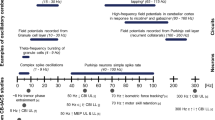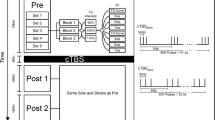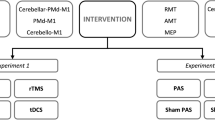Abstract
Cognitive dysfunction is a pervasive and disabling aspect of schizophrenia without adequate treatments. A recognized correlate to cognitive dysfunction in schizophrenia is attenuated frontal theta oscillations. Neuromodulation to normalize these frontal rhythms represents a potential novel therapeutic strategy. Here, we evaluate whether noninvasive neuromodulation of the cerebellum in patients with schizophrenia can enhance frontal theta oscillations, with the future goal of targeting the cerebellum as a possible therapy for cognitive dysfunction in schizophrenia. We stimulated the midline cerebellum using transcranial pulsed current stimulation (tPCS), a noninvasive transcranial direct current that can be delivered in a frequency-specific manner. A single 20-min session of theta frequency stimulation was delivered in nine patients with schizophrenia (cathode on right shoulder). Delta frequency tPCS was also delivered as a control to evaluate for frequency-specific effects. EEG signals from midfrontal electrode Cz were analyzed before and after cerebellar tPCS while patients estimated the passage of 3- and 12-s intervals. Theta oscillations were significantly larger following theta frequency cerebellar tPCS in the midfrontal region, which was not seen with delta frequency stimulation. As previously reported, patients with schizophrenia showed a baseline reduction in accuracy estimating 3- and 12-s intervals relative to control subjects, which did not significantly improve following a single-session theta or delta frequency cerebellar tPCS. These preliminary results suggest that single-session theta frequency cerebellar tPCS may modulate task-related oscillatory activity in the frontal cortex in a frequency-specific manner. These preliminary findings warrant further investigation to evaluate whether multiple sessions delivered daily may have an impact on cognitive performance and have therapeutic implications for schizophrenia.






Similar content being viewed by others
References
McGrath J, Saha S, Chant D, Welham J. Schizophrenia: a concise overview of incidence, prevalence, and mortality. Epidemiol Rev. 2008;30:67–76. https://doi.org/10.1093/epirev/mxn001.
Andreasen NC, Paradiso S, O’Leary DS. “Cognitive dysmetria” as an integrative theory of schizophrenia: a dysfunction in cortical-subcortical-cerebellar circuitry? Schizophr Bull. 1998;24:203–18.
Carroll CA, O’Donnell BF, Shekhar A, Hetrick WP. Timing dysfunctions in schizophrenia span from millisecond to several-second durations. Brain Cogn. 2009;70:181–90.
Green MF, Harvey PD. Cognition in schizophrenia: past, present, and future. Schizophr Res Cogn. 2014;1:e1–9. https://doi.org/10.1016/j.scog.2014.02.001.
Ho BC, Nopoulos P, Flaum M, Arndt S, Andreasen NC. Two-year outcome in first-episode schizophrenia: predictive value of symptoms for quality of life. Am J Psychiatry. 1998;155:1196–201.
Ward RD, Kellendonk C, Kandel ER, Balsam PD. Timing as a window on cognition in schizophrenia. Neuropharmacology. 2011;62:1175–81. https://doi.org/10.1016/j.neuropharm.2011.04.014.
Andreasen NC, O’Leary DS, Flaum M, Nopoulos P, Watkins GL, Boles Ponto LL, et al. Hypofrontality in schizophrenia: distributed dysfunctional circuits in neuroleptic-naïve patients. Lancet. 1997;349:1730–4.
Carter CS, Perlstein W, Ganguli R, Brar J, Mintun M, Cohen JD. Functional hypofrontality and working memory dysfunction in schizophrenia. 2014. Available at: http://ajp.psychiatryonline.org/doi/10.1176/ajp.155.9.1285 [Accessed March 27, 2015].
Parker KL, Kim Y, Kelley RM, Nessler AJ, Chen K-H, Muller-Ewald VA, et al. Delta-frequency stimulation of cerebellar projections can compensate for schizophrenia-related medial frontal dysfunction. Mol Psychiatry. 2017;22:647–55.
Andreasen NC, Pierson R. The role of the cerebellum in schizophrenia. Biol Psychiatry. 2008;64:81–8. https://doi.org/10.1016/j.biopsych.2008.01.003.
Repovs G, Csernansky JG, Barch DM. Brain network connectivity in individuals with schizophrenia and their siblings. Biol Psychiatry. 2011;69:967–73. https://doi.org/10.1016/j.biopsych.2010.11.009.
Abi-Dargham A, Mawlawi O, Lombardo I, Gil R, Martinez D, Huang Y, et al. Prefrontal dopamine D1 receptors and working memory in schizophrenia. J Neurosci. 2002;22:3708–19.
Koziol LF, Budding D, Andreasen N, D’Arrigo S, Bulgheroni S, Imamizu H, et al. Consensus paper: the cerebellum’s role in movement and cognition. Cerebellum. 2013. https://doi.org/10.1007/s12311-013-0511-x.
Schmahmann JD. From movement to thought: anatomic substrates of the cerebellar contribution to cognitive processing. Hum Brain Mapp. 1996;4:174–98. https://doi.org/10.1002/(SICI)1097-0193(1996)4:3<174::AID-HBM3>3.0.CO;2-0.
Schmahmann JD. Dysmetria of thought: clinical consequences of cerebellar dysfunction on cognition and affect. Trends Cogn Sci (Regul Ed). 1998;2:362–71.
Schutter DJLG, van Honk J. An electrophysiological link between the cerebellum, cognition and emotion: frontal theta EEG activity to single-pulse cerebellar TMS. Neuroimage. 2006;33:1227–31. https://doi.org/10.1016/j.neuroimage.2006.06.055.
Stoodley CJ. The cerebellum and cognition: evidence from functional imaging studies. Cerebellum. 2011;11:352–65. https://doi.org/10.1007/s12311-011-0260-7.
Strick PL, Dum RP, Fiez JA. Cerebellum and nonmotor function. Annu Rev Neurosci. 2009;32:413–34. https://doi.org/10.1146/annurev.neuro.31.060407.125606.
Jurjus GJ, Weiss KM, Jaskiw GE. Schizophrenia-like psychosis and cerebellar degeneration. Schizophr Res. 1994;12:183–4. https://doi.org/10.1016/0920-9964(94)90076-0.
Nopoulos PC, Ceilley JW, Gailis EA, Andreasen NC. An MRI study of cerebellar vermis morphology in patients with schizophrenia: evidence in support of the cognitive dysmetria concept. Biol Psychiatry. 1999;46:703–11.
Sandyk R. Psychotic behavior associated with cerebellar pathology. Int J Neurosci. 1993;71:1–7.
Tavano A, Grasso R, Gagliardi C, Triulzi F, Bresolin N, Fabbro F, et al. Disorders of cognitive and affective development in cerebellar malformations. Brain. 2007;130:2646–60. https://doi.org/10.1093/brain/awm201.
Andreasen NC, O’Leary DS, Cizadlo T, Arndt S, Rezai K, Ponto LL, et al. Schizophrenia and cognitive dysmetria: a positron-emission tomography study of dysfunctional prefrontal-thalamic-cerebellar circuitry. Proc Natl Acad Sci U S A. 1996;93:9985–90.
Rüsch N, Spoletini I, Wilke M, Bria P, Di Paola M, Di Iulio F, et al. Prefrontal-thalamic-cerebellar gray matter networks and executive functioning in schizophrenia. Schizophr Res. 2007;93:79–89. https://doi.org/10.1016/j.schres.2007.01.029.
Middleton FA, Strick PL. Basal ganglia and cerebellar loops: motor and cognitive circuits. Brain Res Rev. 2000;31:236–50. https://doi.org/10.1016/S0165-0173(99)00040-5.
Ferrucci R, Cortese F, Bianchi M, Pittera D, Turrone R, Bocci T, et al. Cerebellar and motor cortical transcranial stimulation decrease levodopa-induced dyskinesias in Parkinson’s disease. Cerebellum. 2016;15:43–7. https://doi.org/10.1007/s12311-015-0737-x.
Grimaldi G, Argyropoulos GP, Boehringer A, Celnik P, Edwards MJ, Ferrucci R, et al. Non-invasive cerebellar stimulation-a consensus paper. Cerebellum. 2014;13:121–38. https://doi.org/10.1007/s12311-013-0514-7.
Fregni F, Boggio PS, Nitsche M, Bermpohl F, Antal A, Feredoes E, et al. Anodal transcranial direct current stimulation of prefrontal cortex enhances working memory. Exp Brain Res. 2005;166:23–30. https://doi.org/10.1007/s00221-005-2334-6.
Jo JM, Kim Y-H, Ko M-H, Ohn SH, Joen B, Lee KH. Enhancing the working memory of stroke patients using tDCS. Am J Phys Med Rehabil. 2009;88:404–9. https://doi.org/10.1097/PHM.0b013e3181a0e4cb.
Ferrucci R, Marceglia S, Vergari M, Cogiamanian F, Mrakic-Sposta S, Mameli F, et al. Cerebellar transcranial direct current stimulation impairs the practice-dependent proficiency increase in working memory. J Cogn Neurosci. 2008;20:1687–97. https://doi.org/10.1162/jocn.2008.20112.
Demirtas-Tatlidede A, Freitas C, Cromer JR, Safar L, Ongur D, Stone WS, et al. Safety and proof of principle study of cerebellar vermal theta burst stimulation in refractory schizophrenia. Schizophr Res. 2010;124:91–100. https://doi.org/10.1016/j.schres.2010.08.015.
Garg S, Sinha VK, Tikka SK, Mishra P, Goyal N. The efficacy of cerebellar vermal deep high frequency (theta range) repetitive transcranial magnetic stimulation (rTMS) in schizophrenia: a randomized rater blind-sham controlled study. Psychiatry Res. 2016;243:413–20. https://doi.org/10.1016/j.psychres.2016.07.023.
Vasquez A, Malavera A, Doruk D, Morales-Quezada L, Carvalho S, Leite J, et al. Duration dependent effects of transcranial pulsed current stimulation (tPCS) indexed by electroencephalography. Neuromodulation. 2016;19:679–88. https://doi.org/10.1111/ner.12457.
Ivry RB, Spencer RM. The neural representation of time. Curr Opin Neurobiol. 2004;14:225–32. https://doi.org/10.1016/j.conb.2004.03.013.
Parker KL, Chen K-H, Kingyon JR, Cavanagh JF, Naryanan NS. Medial frontal ~4 Hz activity in humans and rodents is attenuated in PD patients and in rodents with cortical dopamine depletion. J Neurophysiol. 2015. https://doi.org/10.1152/jn.00412.2015.
Rakitin BC, Gibbon J, Penney TB, Malapani C, Hinton SC, Meck WH. Scalar expectancy theory and peak-interval timing in humans. J Exp Psychol Anim Behav Process. 1998;24:15–33.
Gibbon J, Church RM, Meck WH. Scalar timing in memory. Ann N Y Acad Sci. 1984;423:52–77.
Buhusi CV, Meck WH. What makes us tick? Functional and neural mechanisms of interval timing. Nat Rev Neurosci. 2005;6:755–65. https://doi.org/10.1038/nrn1764.
Parker KL, Chen K-H, Kingyon JR, Cavanagh JF, Narayanan NS. D1-dependent 4 Hz oscillations and ramping activity in rodent medial frontal cortex during interval timing. J Neurosci. 2014;34:16774–83. https://doi.org/10.1523/JNEUROSCI.2772-14.2014.
Gülekon IN, Turgut HB. The external occipital protuberance: can it be used as a criterion in the determination of sex? J Forensic Sci. 2003;48:513–6.
Bocci T, Santarcangelo E, Vannini B, Torzini A, Carli G, Ferrucci R, et al. Cerebellar direct current stimulation modulates pain perception in humans. Restor Neurol Neurosci. 2015;33:597–609. https://doi.org/10.3233/RNN-140453.
Bocci T, Ferrucci R, Barloscio D, Parenti L, Cortese F, Priori A, et al. Cerebellar direct current stimulation modulates hand blink reflex: implications for defensive behavior in humans. Phys Rep. 2018;6. https://doi.org/10.14814/phy2.13471.
Ferrucci R, Giannicola G, Rosa M, Fumagalli M, Boggio PS, Hallett M, et al. Cerebellum and processing of negative facial emotions: cerebellar transcranial DC stimulation specifically enhances the emotional recognition of facial anger and sadness. Cognit Emot. 2012;26:786–99. https://doi.org/10.1080/02699931.2011.619520.
Ferrucci R, Brunoni AR, Parazzini M, Vergari M, Rossi E, Fumagalli M, et al. Modulating human procedural learning by cerebellar transcranial direct current stimulation. Cerebellum. 2013;12:485–92. https://doi.org/10.1007/s12311-012-0436-9.
van Driel J, Sligte IG, Linders J, Elport D, Cohen MX. Frequency band-specific electrical brain stimulation modulates cognitive control processes. PLoS One. 2015;10:e0138984. https://doi.org/10.1371/journal.pone.0138984.
Cohen MX. Analyzing neural time series data: theory and practice (issues in clinical and cognitive neuropsychology). The MIT Press; 2014.
Delorme A, Makeig S. EEGLAB: an open source toolbox for analysis of single-trial EEG dynamics including independent component analysis. J Neurosci Methods. 2004;134:9–21. https://doi.org/10.1016/j.jneumeth.2003.10.009.
Cavanagh JF, Frank MJ. Frontal theta as a mechanism for cognitive control. Trends Cogn Sci. 2014;18(8):414-2.
Singh A, Richardson SP, Narayanan N, Cavanagh JF Mid-frontal theta activity is diminished during cognitive control in Parkinson's disease. Neuropsychologia. 2018;117:113-122.
Malapani C, Deweer B, Gibbon J. Separating storage from retrieval dysfunction of temporal memory in Parkinson’s disease. J Cogn Neurosci. 2002;14:311–22. https://doi.org/10.1162/089892902317236920.
Ozen S, Sirota A, Belluscio MA, Anastassiou CA, Stark E, Koch C, et al. Transcranial electric stimulation entrains cortical neuronal populations in rats. J Neurosci. 2010;30:11476–85. https://doi.org/10.1523/JNEUROSCI.5252-09.2010.
Parazzini M, Rossi E, Ferrucci R, Liorni I, Priori A, Ravazzani P. Modelling the electric field and the current density generated by cerebellar transcranial DC stimulation in humans. Clin Neurophysiol. 2014;125:577–84. https://doi.org/10.1016/j.clinph.2013.09.039.
Vöröslakos M, Takeuchi Y, Brinyiczki K, Zombori T, Oliva A, Fernández-Ruiz A, et al. Direct effects of transcranial electric stimulation on brain circuits in rats and humans. Nat Commun. 2018;9:483. https://doi.org/10.1038/s41467-018-02928-3.
Underwood E. How the body learns to hurt. Science. 2016;354:694. https://doi.org/10.1126/science.354.6313.694.
Halko MA, Farzan F, Eldaief MC, Schmahmann JD, Pascual-Leone A. Intermittent Theta-burst stimulation of the lateral cerebellum increases functional connectivity of the default network. J Neurosci. 2014;34:12049–56. https://doi.org/10.1523/JNEUROSCI.1776-14.2014.
Funding
K.L.P has received generous funding to complete this research from the Brain & Behavior Foundation Young Investigator NARSAD Award, The Nellie Ball Research Trust, and NIMH K01 MH106824, the University of Iowa Department of Psychiatry, and the Iowa Neuroscience Institute.
Author information
Authors and Affiliations
Contributions
K.L.P. designed the research; K.L.P. and S.C acquired data; K.L.P., A.S., B.D., and J.K. analyzed data; K.L.P., N.T.T., A.D.B., B.D., and A.S. wrote the manuscript; and all authors provided feedback.
Corresponding author
Ethics declarations
Written informed consent was obtained from every subject and all research protocols were approved by the University of Iowa Human Subjects Review Board.
Competing Interests
The authors declare that they have no competing interests.
Additional information
Publisher’s Note
Springer Nature remains neutral with regard to jurisdictional claims in published maps and institutional affiliations.
Arun Singh and Nicholas T. Trapp are co-first authors.
Rights and permissions
About this article
Cite this article
Singh, A., Trapp, N.T., De Corte, B. et al. Cerebellar Theta Frequency Transcranial Pulsed Stimulation Increases Frontal Theta Oscillations in Patients with Schizophrenia. Cerebellum 18, 489–499 (2019). https://doi.org/10.1007/s12311-019-01013-9
Published:
Issue Date:
DOI: https://doi.org/10.1007/s12311-019-01013-9




